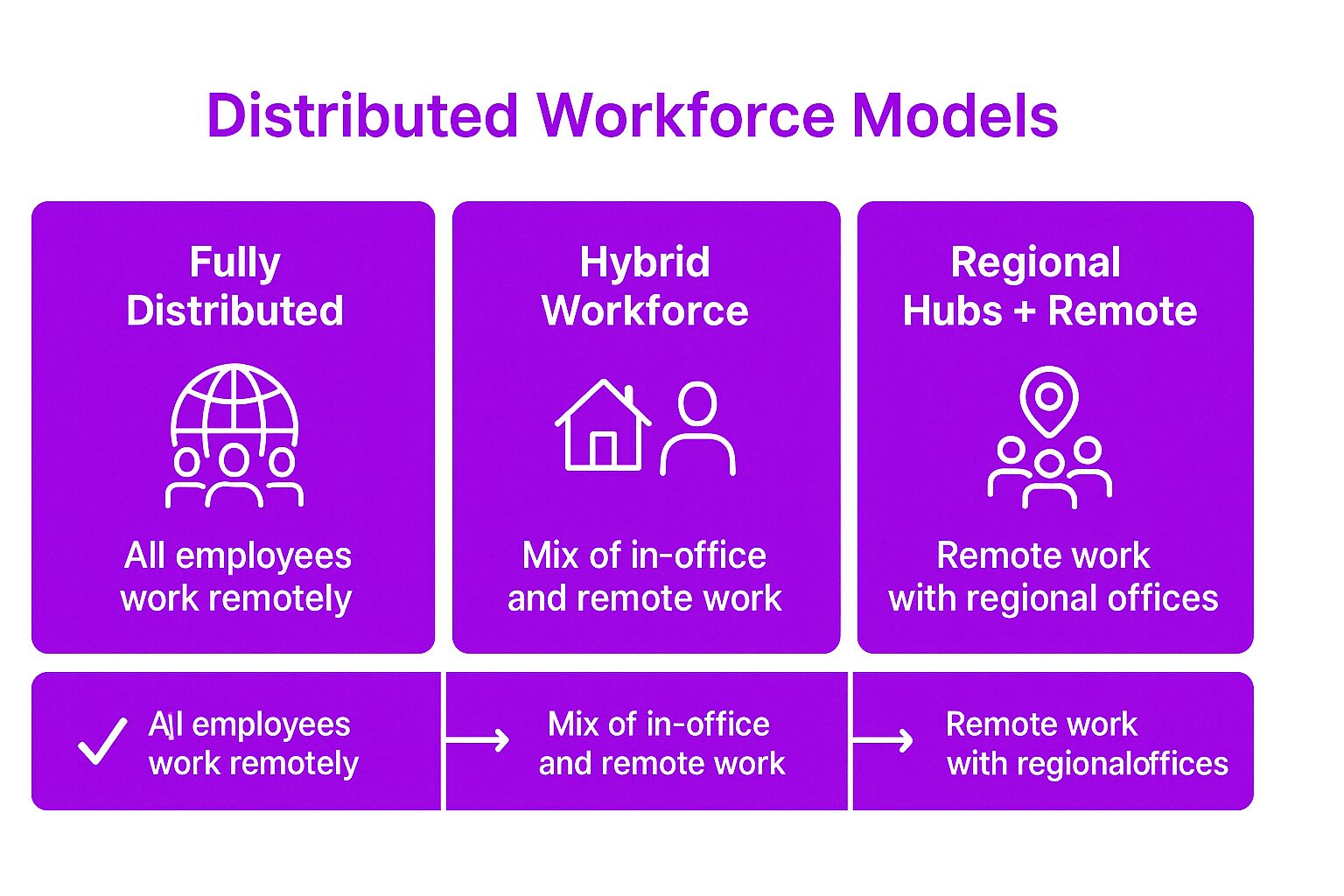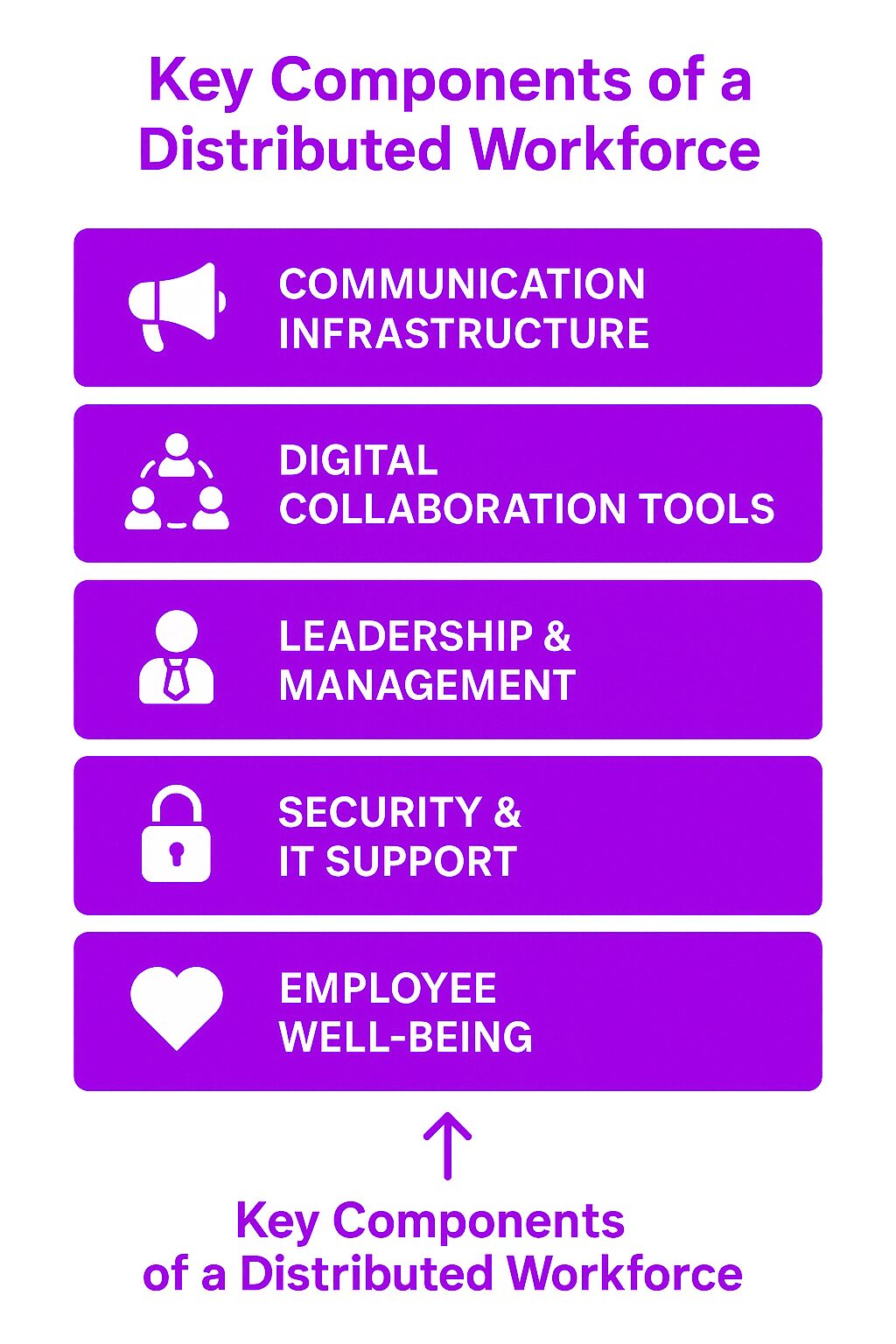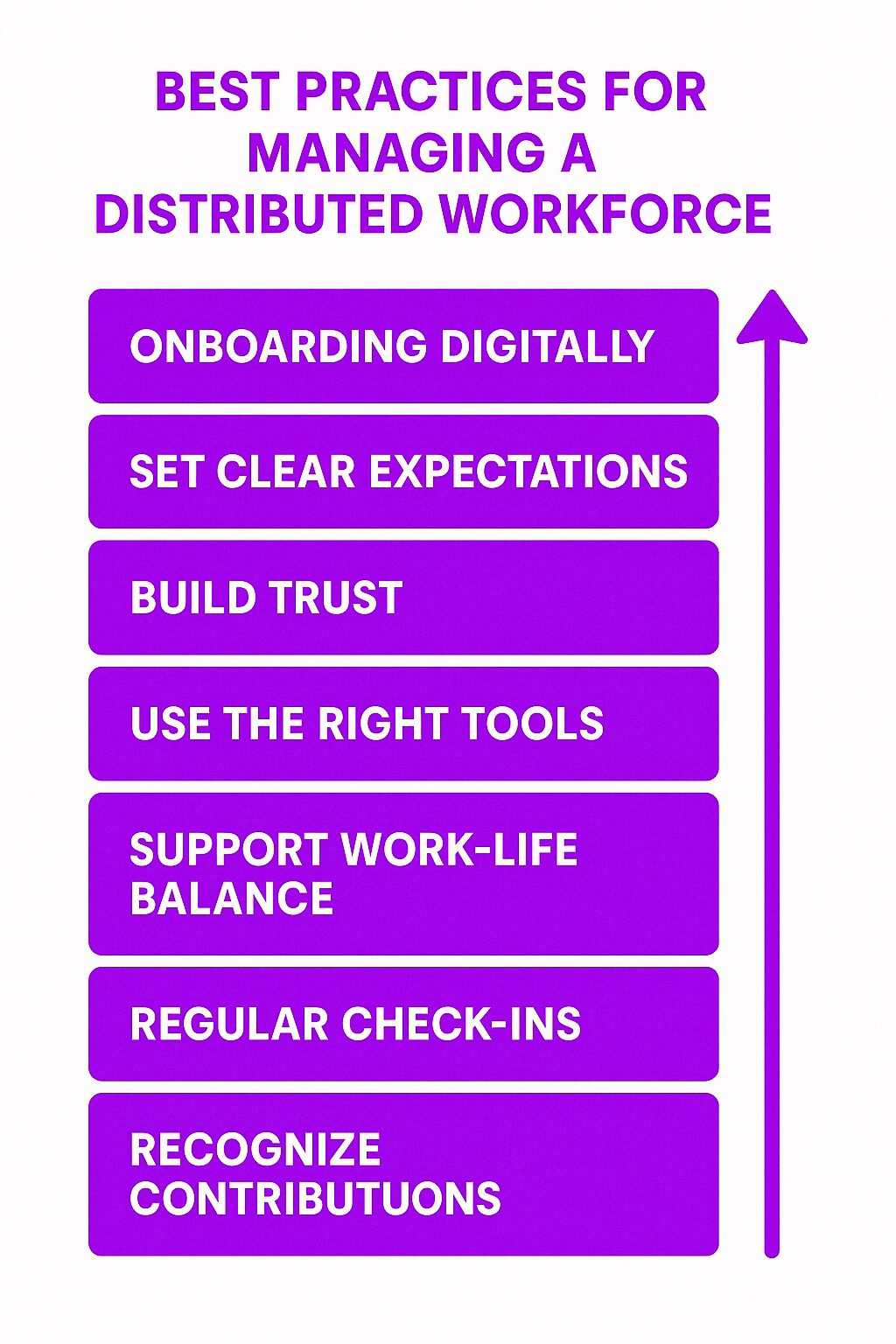What Is a Distributed Workforce?
A distributed workforce is a team of employees who work across multiple locations rather than being centralized in a single office. This structure allows distributed employees to operate remotely and contribute significantly to the organization, even if they never meet their colleagues face-to-face. Unlike a traditional workforce, where most employees report to a physical office, a distributed workforce relies on digital tools to maintain productivity, communication, and alignment.
Companies adopt distributed workforces to reduce overhead costs, expand their talent pool, and provide employees with more flexibility. The rise of cloud computing, collaboration platforms, and digital communication tools has made distributed workforces more viable and efficient than ever before.
How a Distributed Workforce Works
A distributed workforce requires structured systems and processes to function effectively. Distributed work is a work environment where employees are geographically dispersed and operate from various locations rather than a centralized office. Employees need access to cloud-based applications, secure communication channels, and project management tools to ensure smooth collaboration. Organizations also need strategies to support team cohesion, productivity tracking, and cybersecurity in remote work environments.
Distributed workforces can take different forms:
-
Fully Distributed Workforce: All employees work remotely from various locations.
-
Hybrid Workforce: A mix of remote and in-office employees.
-
Regional Offices and Remote Employees: Companies maintain smaller offices while allowing some employees to work remotely.
The success of a distributed workforce depends on strong leadership, clear expectations, and an emphasis on digital collaboration.
Key Components of a Distributed Workforce
1. Communication Infrastructure
Clear communication is essential to connect and engage distributed team members, preventing misunderstandings and ensuring alignment. Companies invest in:
-
Messaging apps (Slack, Microsoft Teams)
-
Video conferencing tools (Zoom, Google Meet)
-
Email and document-sharing platforms (Google Workspace, Microsoft 365)
2. Digital Collaboration Tools
Employees rely on cloud-based platforms to manage tasks and projects efficiently. Key tools include:
-
Project management software (Asana, Trello, Monday.com)
-
Document collaboration tools (Google Docs, SharePoint)
-
Time tracking and productivity apps (Toggl, RescueTime)
3. Leadership and Management Strategies
Managing a distributed workforce requires trust and autonomy. In today’s modern work environments, distributed workforce management has become increasingly significant, necessitating effective strategies to handle the benefits and challenges it presents. Leaders must:
-
Set clear expectations for deliverables and deadlines.
-
Foster a culture of accountability.
-
Use performance tracking tools rather than micromanaging.
4. Security and IT Support
Cybersecurity is a top priority in a distributed workforce. Organizations implement:
-
Secure VPNs to protect company data.
-
Multi-factor authentication (MFA) to prevent unauthorized access.
-
Regular security training to educate employees about potential threats.
5. Employee Well-being and Engagement
A distributed workforce must address potential challenges such as isolation and burnout. Engaging distributed workers is crucial, as they face unique challenges that require effective communication and regular performance reviews to maintain morale. Companies promote well-being by:
-
Offering virtual team-building activities.
-
Encouraging work-life balance.
-
Providing access to mental health resources.
Purpose and Importance of a Distributed Workforce
Organizations adopt a distributed workforce model to:
-
Expand their talent pool by hiring from different regions and countries.
-
Reduce operational costs associated with maintaining large office spaces.
-
Improve employee retention by offering flexibility and remote work opportunities.
-
Enhance productivity by allowing employees to work in environments where they thrive.
-
Ensure business continuity in case of unforeseen disruptions like pandemics or natural disasters.
Benefits of a Distributed Workforce
1. Access to Global Talent
Businesses can hire the best candidates regardless of geographic limitations. This leads to:
-
Increased diversity in perspectives and skills.
-
More competitive hiring strategies.
2. Cost Savings
Reducing or eliminating physical office space results in:
-
Lower real estate and utility costs.
-
Decreased expenses for office supplies and commuting reimbursements.
3. Increased Employee Productivity
Employees who work remotely often experience:
-
Fewer workplace distractions.
-
Greater autonomy and job satisfaction.
4. Better Work-Life Balance
Employees have more flexibility to structure their workdays, leading to:
-
Higher morale.
-
Reduced burnout and stress levels.
5. Business Continuity and Resilience
Distributed workforces can continue operating during:
-
Natural disasters.
-
Health crises and pandemics.
-
Other workplace disruptions.
Challenges of a Distributed Workforce
1. Communication Barriers
Without face-to-face interaction, distributed teams may experience:
-
Misinterpretations of messages.
-
Delays in responses and decision-making.
2. Managing Productivity
Ensuring employees remain engaged requires:
-
Setting clear KPIs and performance metrics.
-
Using productivity tracking tools.
3. Security Risks
Remote work introduces data security risks, including:
-
Unsecured Wi-Fi networks.
-
Phishing attacks and cyber threats.
4. Time Zone Differences
Coordinating meetings across different time zones can be difficult. Solutions include:
-
Establishing core working hours for overlapping schedules.
-
Using asynchronous communication when possible.
5. Maintaining Company Culture
Building a cohesive team without a shared physical space requires:
-
Virtual team bonding activities.
-
Strong leadership that fosters inclusion and engagement.
Distributed Workforce Models
A distributed workforce model is a strategic approach to managing a team of employees who work from multiple locations, often remotely. This model has gained popularity in recent years due to advances in technology and the changing needs of the modern workforce. In this section, we will explore the different types of distributed workforce models and their benefits.
Best Practices for Managing a Distributed Workforce
1. Implement Strong Onboarding Practices
-
Provide digital onboarding materials and training sessions.
-
Assign mentors or onboarding buddies.
2. Set Clear Expectations
-
Define performance goals and deliverables.
-
Establish communication guidelines and working hours.
3. Foster a Culture of Trust
-
Allow employees autonomy over their work.
-
Focus on results rather than micromanaging.
4. Leverage the Right Technology
Use cloud-based tools for seamless collaboration among remote teams.
Invest in cybersecurity software to protect company data.
5. Encourage Work-Life Balance
-
Discourage excessive overtime.
-
Promote flexibility in work schedules.
6. Conduct Regular Check-Ins
-
Hold weekly or biweekly virtual meetings.
-
Encourage team members to provide feedback on processes.
7. Recognize and Reward Contributions
-
Celebrate remote workers’ achievements through virtual shoutouts or bonuses.
-
Create engagement programs to foster motivation.
Related Sub-Concepts
1. Remote Workforce vs. Distributed Workforce
-
Remote Workforce: Employees work from home but may still be located within the same region. The rise of remote workforces has become an integral aspect of modern work structures, emphasizing flexibility, work/life balance, and the ability to attract diverse talent.
-
Distributed Workforce: Employees are spread across multiple locations globally, with no central office.
2. Hybrid Workforce
-
A mix of in-office and remote employees working in flexible arrangements.
3. Digital Workplace
-
The technology and tools that enable distributed workforces to function efficiently.
Real-World Examples of Distributed Workforces
1. Automattic (WordPress Parent Company)
-
Fully remote workforce with employees across 75+ countries.
-
Uses asynchronous communication and team retreats.
2. GitLab
-
One of the largest all-remote companies.
-
Operates with transparent documentation and distributed team collaboration.
3. Zapier
-
Fully distributed since its inception.
-
Relies heavily on automation and remote-friendly workflows.
4. Shopify’s Transition to Remote Work
-
Shifted to a “Digital by Default” strategy post-pandemic.
-
Offers employees flexibility while maintaining productivity standards.
The Future of Distributed Workforces
As working remotely continues to grow, distributed workforce models will become more prevalent. Companies will focus on refining digital collaboration, investing in employee experience, and strengthening cybersecurity measures to support their dispersed teams.
By adopting a distributed workforce strategy, organizations can remain competitive, attract top talent, and future-proof their operations in an increasingly globalized world.








